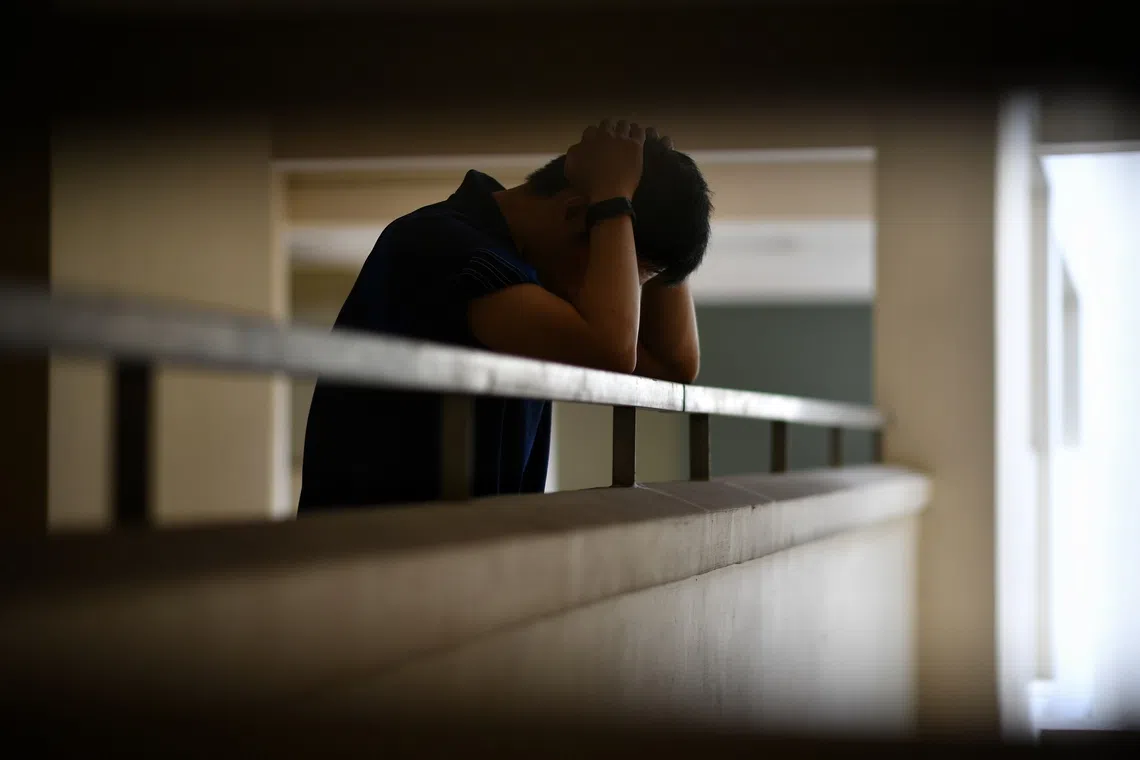Many of those who died by suicide showed warning signs like mood changes in week before death: IMH
Survivors of the person who died by suicide said they were unable to distinguish stress from serious mental health conditions like depression or psychosis. PHOTO: ST FILE
Summary
- IMH's study (2021-2024) found increased warning signs like mood changes and recklessness in the week before suicides in Singapore.
- Those who died by suicide were more likely to have a history of suicide attempts and unusual social media posts.
- Common factors among those who died by suicide included family mental illness history and insomnia.
SINGAPORE – Individuals who died by suicide showed warning signs such as mood changes, anger and recklessness in the week before their demise, said a new study by the Institute of Mental Health (IMH).
They were also more likely than the general population to post content on social media before their death that was out of the ordinary, and to have a history of suicide attempts.
Based on the findings, IMH said there is a need for greater mental health literacy in Singapore so that family members, friends and communities can better recognise the warnings signs and intervene early.
The study, titled Seeking Answers: A Psychological Autopsy Of Exploring And Analysing Risk Factors, is the first in Singapore to use the psychological autopsy method.
This involves a detailed examination of the life and state of mind of the person who died based on information from those who survived the individual, such as family members, close friends and care providers.
It identified key factors associated with suicides in Singapore and warning signs that families and friends can look out for. The aim is to get a good idea of an individual’s circumstances, personality and health to understand what could have led to their death.
Researchers conducted interviews with people close to 73 individuals who died by suicide between 2021 and 2024. The team also selected 73 individuals from the general population as a control group to serve as a baseline for what is typical.
Through the interviews and comparisons, the study identified possible unique factors associated with suicide.
The suicide cases showed more warning signs drawn from the 10 identified by the American Association of Suicidology: ideation, substance abuse, purposelessness, anxiety, feeling trapped, hopelessness, withdrawal, anger, recklessness and mood changes.
Around 40 per cent of the cases studied had previous suicide attempts, with more than a quarter of them having made an attempt in the year before their death.
Stressing the need for greater mental health literacy, IMH said in a statement on Sept 17 that survivors of the person who died by suicide said they were unable to distinguish stress from serious mental health conditions like depression or psychosis. This led to delayed seeking of treatment.
They focused on alleviating the stressor, but did not fully understand the importance of professional treatment and did not insist that the person seek care.
Among those who lost an older adult to suicide, the mental health problems were often overlooked if the person was already receiving treatment for other medical conditions like pain.
Professor Chong Siow Ann, a senior consultant at IMH’s research division and department of psychosis, said: “Warning signs such as withdrawal, hopelessness or mood changes can sometimes be subtle or mistaken for normal stress. It is not always straightforward, but this means that there were opportunities to notice changes if people around them were aware of what to look for.”
With better mental health literacy, families, teachers, employers and peers can become more confident in recognising when something is amiss and intervening early, he added.
A common misconception is that talking about suicide might put the idea into someone’s head, Prof Chong noted. Research has shown this is not the case, he said.
“On the contrary, suicidal thoughts often exist long before they are expressed and not talking about it risks isolating them further,” he said.
He added that if a loved one seems withdrawn, hopeless, unusually anxious, or expresses thoughts of being a burden, that is the moment to reach out.
“Doing so gives relief, validates their pain and creates space for connection.”
Reaching out can then be followed up with concrete steps such as encouraging professional help, connecting them to hotlines or community resources, or simply getting them to stay present, he added.
The study also identified other common factors in the 73 cases of suicides. The cases were more likely to have a family history of mental illness than the members of the control group.
More than half of the cases of suicide were reported to have functional limitations in the month before their death, indicating they had trouble performing work or other activities.
They were also more likely to experience insomnia in the weeks before their death.
In terms of lifestyle factors, those who died by suicide were more likely to drink frequently and smoke than the control group.
More than 70 per cent of the suicide cases had been diagnosed with a mental health condition, with major depressive disorder being the most common.
Around 30 per cent of the individuals were unemployed in the past year.
Associate Professor Mythily Subramaniam, who is the principal investigator of the study and assistant chairman of IMH’s medical board for research, said that one of the most important messages from the study is the need for open, honest conversations about suicide.
“These are never easy – I’ve found it difficult to broach the topic with my children. Yet with young people increasingly exposed to it through school, social media and peer circles, silence is not an option,” she said.
“Suicide prevention isn’t just about services or professionals. It’s about all of us playing a role in supporting friends, families, colleagues and the larger community, and having the courage to reach out when we notice something is wrong,” she said.
“When people feel they can talk about their struggles without shame, the chances of getting help in time are much greater, and hopefully we can prevent some suicides.”
Helplines
Mental well-being
- National helpline: 1771 (24 hours) / 6669-1771 (via WhatsApp)
- Samaritans of Singapore: 1-767 (24 hours) / 9151-1767 (24 hours CareText via WhatsApp)
- Singapore Association for Mental Health: 1800-283-7019
- Silver Ribbon Singapore: 6386-1928
- Chat, Centre of Excellence for Youth Mental Health: 6493-6500/1
- Women’s Helpline (Aware): 1800-777-5555 (weekdays, 10am to 6pm)
- The Seniors Helpline: 1800-555-5555 (weekdays, 9am to 5pm)
Counselling
- Touchline (Counselling): 1800-377-2252
- Touch Care Line (for caregivers): 6804-6555
- Counselling and Care Centre: 6536-6366
- We Care Community Services: 3165-8017
- Shan You Counselling Centre: 6741-9293
- Clarity Singapore: 6757-7990
Online resources


